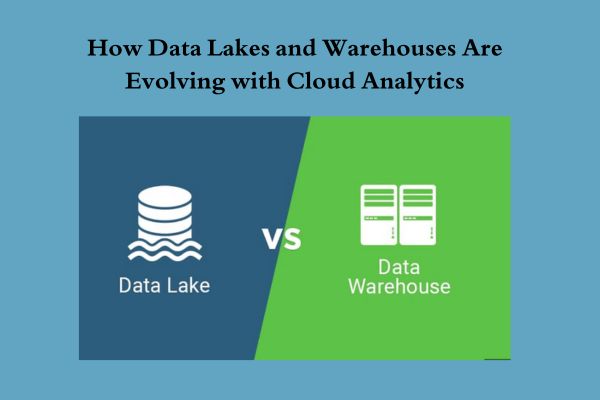How Data Lakes and Warehouses Are Evolving with Cloud Analytics
 Brijesh Prajapati
Brijesh Prajapati
As businesses generate increasing amounts of data, the demand for efficient storage, management, and analytics solutions has grown. Traditional approaches, such as data lakes and warehouses, have long helped manage large volumes of data. However, the rise of cloud computing and cloud-based analytics tools is revolutionizing how these systems operate. This article explores the evolution of data lakes and warehouses with cloud analytics and examines how these advancements are reshaping the data landscape.
Understanding Data Lakes and Warehouses
Data Lakes
A data lake is a centralized repository that stores vast amounts of structured, semi-structured, and unstructured data. Unlike traditional databases, which require data to be structured before storage, data lakes maintain data in its raw format. This flexibility allows organizations to collect and store data from multiple sources without pre-processing. Data lakes are particularly useful for machine learning and advanced analytics, as they offer a diverse pool of data for analysis.
Data Warehouses
In contrast, a data warehouse is a system designed to store and analyze structured data. Data is pre-processed and formatted before entering the warehouse, making it ideal for reporting and business intelligence tasks. Data warehouses are commonly used to run complex queries and generate reports based on historical data. Their focus on consistency and accuracy makes them highly suitable for analytical workloads.
The Evolution of Data Lakes and Warehouses with Cloud Analytics
The Role of Cloud Computing
Cloud computing has significantly transformed how data lakes and warehouses function. Traditional on-premises systems often face challenges related to scalability, security, and cost. Cloud platforms like AWS, Google Cloud, and Microsoft Azure provide scalable, secure, and cost-effective solutions for storing and processing data. These platforms enable businesses to focus on leveraging data without needing to manage the underlying infrastructure.
Cloud analytics tools integrate seamlessly with cloud storage, enabling faster and more efficient insights. For instance, cloud-based data lakes allow businesses to scale storage on demand, avoiding capacity limitations. Similarly, cloud platforms offer managed services for data warehouses, simplifying both setup and maintenance.
Data Lakes in the Cloud
Cloud-based data lakes have seen significant improvements. They allow organizations to store large volumes of data at lower costs compared to traditional storage systems. Cloud services like AWS S3, Azure Data Lake, and Google Cloud Storage are designed for unstructured data and offer excellent data integration. Businesses can now ingest data from diverse sources such as IoT devices, social media, and enterprise systems.
A key advantage of cloud-based data lakes is their ability to support real-time analytics. By connecting with cloud analytics tools, businesses can perform real-time data processing and analysis, enabling them to make data-driven decisions faster.
Cloud-Based Data Warehouses
Cloud data warehouses have also undergone significant enhancements. Traditionally, scaling data warehouses was costly, requiring substantial investments in hardware. Cloud platforms solve this problem with scalable, pay-as-you-go options. Services like Amazon Redshift, Google BigQuery, and Azure Synapse Analytics provide fully managed solutions, allowing businesses to adjust their storage and processing capacity as needed.
Cloud-based data warehouses also offer faster query processing and improved performance through distributed computing. Businesses can analyze data across multiple regions, enabling global data access and collaboration. Additionally, many cloud providers integrate machine learning and AI tools, empowering companies to apply advanced analytics and predictive modeling.
The Integration of Data Lakes and Warehouses
The Emergence of Lakehouse Architecture
One of the most significant trends is the convergence of data lakes and warehouses into a hybrid model known as "lakehouse" architecture. This approach combines the scalability and flexibility of data lakes with the structured reliability of data warehouses. Lakehouse architecture allows businesses to store raw data, as in a data lake, while also supporting the querying and processing of structured data, similar to a data warehouse.
By leveraging cloud technology, lakehouses provide unified platforms for data storage and analytics. This helps organizations streamline data workflows and reduces the need for separate systems to handle unstructured and structured data. Furthermore, lakehouse architectures support both batch and real-time analytics, making them versatile for various use cases.
Simplified Data Management
Cloud platforms have simplified data management for both lakes and warehouses. Features such as automated data replication, backup, and recovery ensure data availability and security. Advanced security measures like encryption and identity management are integrated into cloud services, protecting sensitive information.
Cloud technology has also improved data governance. Cloud-based tools allow businesses to establish clear data governance policies, ensuring authorized access and regulatory compliance.
Benefits of Cloud Analytics for Data Lakes and Warehouses
Cost-Effectiveness
Migrating data lakes and warehouses to the cloud offers significant cost savings. Traditional systems require large upfront investments in hardware, software, and maintenance. Cloud solutions eliminate the need for these expenditures by offering a pay-as-you-go model. This makes cloud analytics accessible to businesses of all sizes.
Scalability
Scalability is another major advantage of cloud-based solutions. Whether a business needs to expand storage capacity or increase computational power, cloud platforms can scale up or down according to demand. This flexibility is crucial for organizations dealing with fluctuating data volumes or seasonal workloads.
Accessibility and Collaboration
Cloud analytics enhances accessibility and collaboration across teams. With cloud-based data lakes and warehouses, employees can access data from anywhere, fostering remote work and global collaboration. Real-time data sharing ensures that teams have the most current information, improving decision-making processes.
Conclusion
The evolution of data lakes and warehouses with cloud analytics is transforming how businesses store, manage, and analyze data. Cloud platforms deliver scalable, cost-effective, and efficient solutions for handling both structured and unstructured data, enabling businesses to gain insights faster and more effectively. As cloud analytics tools continue to advance, the integration of data lakes and warehouses will lead to even more powerful and flexible data management systems.
For those looking to build expertise in this field, a Data Analytics Certification Course in Bhopal and all cities in India offers the knowledge needed to navigate these modern data architectures. Cloud analytics is not just shaping the future—it is driving the present, giving businesses new ways to unlock the full potential of their data.
Subscribe to my newsletter
Read articles from Brijesh Prajapati directly inside your inbox. Subscribe to the newsletter, and don't miss out.
Written by

Brijesh Prajapati
Brijesh Prajapati
I'm a digital marketer eager to expand my skills and knowledge. Passionate about staying updated with the latest trends, I thrive on learning new techniques and strategies to enhance my expertise.